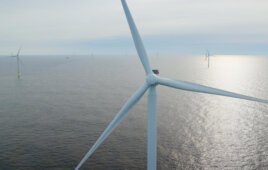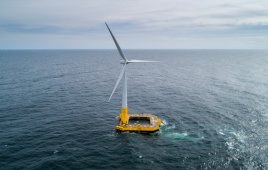
An experiment at the Sandia National Laboratories Scaled Wind Farm Technology facility successfully demonstrated wake steering, which will help wind power plants increase energy capture. Photo by Jon White, Sandia National Laboratories
A recently completed wake-steering experiment at the Sandia National Laboratories Scaled Wind Farm Technology (SWiFT) facility has successfully demonstrated that the wake from an upwind turbine can be steered away from a downwind turbine by yawing the upwind turbine.
The results will enable the wind industry to evaluate the potential for yaw-based wake steering to improve the performance of both existing and new wind power plants around the country, which could lead to higher, more predictable output from wind plants and lower operating costs. This ultimately could reduce the cost of wind energy overall, according to DOE’s Office of Energy Efficiency and Renewable Energy.
The wake of a turbine is a region of lower wind speed and increased turbulence that reduces the power output and increases damaging loads on downwind turbines in its path. By yawing the upwind turbine so that the incoming flow hits the turbine at an angle, the wake deflects laterally. Under the right conditions, the wake can avoid the downwind turbine altogether, leading to higher total energy capture in a wind plant.
Currently, researchers from Sandia and the National Renewable Energy Laboratory are analyzing the data from the SWiFT site instrumentation. They will calculate the power and loads on the two turbines, along with the wake location as it reacts to the yaw control action. This analysis will quantify the uncertainty in the measurements and the factors that most influence the performance of the wind plant to ensure the results are accurate and reliable.
The technical details of the controller, turbine, and experimental data are all public, helping to facilitate rapid technology transfer from the U.S. Department of Energy to the wind industry.
Filed Under: News, Offshore wind




